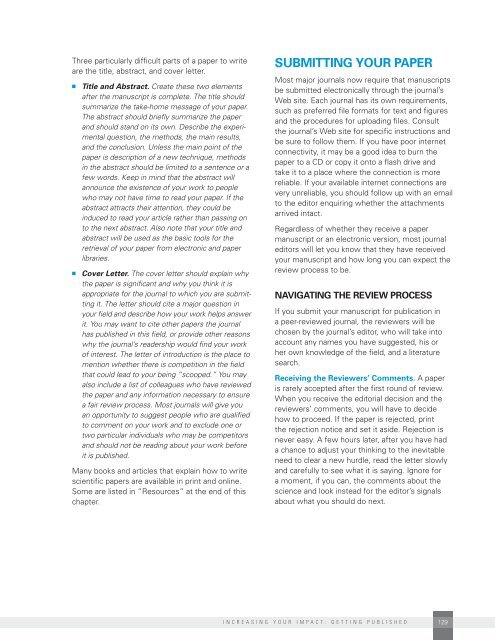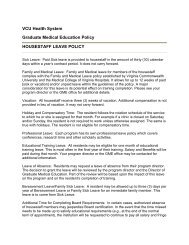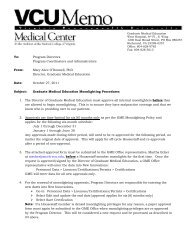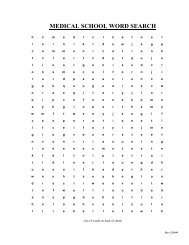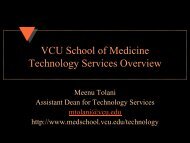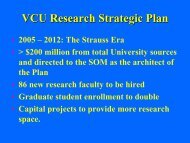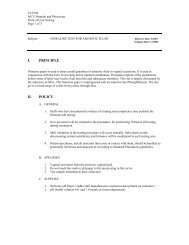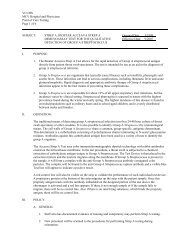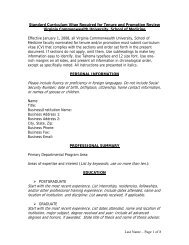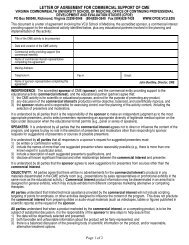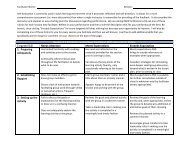may need to take the first author position yourself,especially if you are early in your career andbuilding your reputation. Generally, in multi-authorpapers the first and final names on the list are theones the reader will remember.This is a sticky problem, since <strong>of</strong>ten among themultiple authors there are more than two peoplewho have worked hard to generate the data andthe thinking necessary to tell the story, and whoneed the benefits that come from taking one <strong>of</strong>these positions. It will be important for the peopleyou train to get first authorships themselves.If someone above you at your institute alwaystakes one <strong>of</strong> the prestige spots and you needto take the other one, over time it will be veryhard for your students to advance. But as ayoung researcher, it may be dangerous for you toargue against this situation. As your own careeradvances and your reputation becomes solid, youmay be able to move yourself to second-to-lastauthorship, so that your trainees can shine. Overtime your international colleagues, funders, andjournal editors should come to view you as senior.Compliance with the authorship criteria <strong>of</strong> theInternational Committee <strong>of</strong> Medical JournalEditors and the implementation <strong>of</strong> a memorandum<strong>of</strong> initiation for each project, in which the roles<strong>of</strong> participants and the principles for determiningorder <strong>of</strong> authorship are stated, can diminish theworry, hard feelings, and sense <strong>of</strong> inequality thatcan come when distributing authorship, which is afundamentally important and greatly coveted form<strong>of</strong> recognition. (See chapter 4, pages 63-65, formore discussion <strong>of</strong> authorship.)The author who has actually done the hands-onwork should be the person to prepare the figures,tables, and legends first, because a scientificpaper is best written with the final form <strong>of</strong> thedata in front <strong>of</strong> the writer. Then work with theauthor to get the paper into shape. Although thismay not be the most efficient way to write apaper—there will be times when you could do ityourself much faster—it is important for peopleyou have trained to gain experience and feedbackon writing papers.Once you have a good first draft, send it tocolleagues in your field and in your departmentfor review. Have it pro<strong>of</strong>read by someone in yourlab with access to your data and the documentsyou have cited. The last thing you want to do isto appear careless; doing so will raise suspicionsabout the quality <strong>of</strong> all <strong>of</strong> your work. It is also agood idea to give the paper to someone outsideyour field to see whether they understand itsimportance. As mentioned in the section above, ifthe journal is not in your first language, it is a goodidea to ask a friend or colleague who is a nativeor near-native speaker <strong>of</strong> the language for help.If your speaking skills in that language are trulyexcellent but you struggle with the rules <strong>of</strong> itsgrammar, reading the paper aloud can make anywritten errors more obvious. This is true for nativespeakers as well.The “who writes the manuscript” problem isnot trivial. I personally like to write the draft <strong>of</strong>every graduate student’s first paper. For [thestudent’s] second paper, he or she writes thefirst draft. Postdocs always write their firstdrafts. Sometimes it is more difficult to edit orchange a draft written by someone else thanwriting the draft directly oneself.”Alberto Kornblihtt, ArgentinaIn terms <strong>of</strong> other principles I would commentthat because thesis research is by definitionthe original research <strong>of</strong> the student, thestudent should have the opportunity to be thefirst author <strong>of</strong> the publication <strong>of</strong> this work. Ifthe student is unable to draft the manuscriptwithin a reasonable and, ideally, pre-establishedperiod <strong>of</strong> time, then first authorship maycorrespond to the investigator who assumesthe writing <strong>of</strong> the paper.”Nancy Gore Saravia, Colombia128 excellence everywhere
Three particularly difficult parts <strong>of</strong> a paper to writeare the title, abstract, and cover letter.n Title and Abstract. Create these two elementsafter the manuscript is complete. The title shouldsummarize the take-home message <strong>of</strong> your paper.The abstract should briefly summarize the paperand should stand on its own. Describe the experimentalquestion, the methods, the main results,and the conclusion. Unless the main point <strong>of</strong> thepaper is description <strong>of</strong> a new technique, methodsin the abstract should be limited to a sentence or afew words. Keep in mind that the abstract willannounce the existence <strong>of</strong> your work to peoplewho may not have time to read your paper. If theabstract attracts their attention, they could beinduced to read your article rather than passing onto the next abstract. Also note that your title andabstract will be used as the basic tools for theretrieval <strong>of</strong> your paper from electronic and paperlibraries.n Cover Letter. The cover letter should explain whythe paper is significant and why you think it isappropriate for the journal to which you are submittingit. The letter should cite a major question inyour field and describe how your work helps answerit. You may want to cite other papers the journalhas published in this field, or provide other reasonswhy the journal’s readership would find your work<strong>of</strong> interest. The letter <strong>of</strong> introduction is the place tomention whether there is competition in the fieldthat could lead to your being “scooped.” You mayalso include a list <strong>of</strong> colleagues who have reviewedthe paper and any information necessary to ensurea fair review process. Most journals will give youan opportunity to suggest people who are qualifiedto comment on your work and to exclude one ortwo particular individuals who may be competitorsand should not be reading about your work beforeit is published.Many books and articles that explain how to writescientific papers are available in print and online.Some are listed in “Resources” at the end <strong>of</strong> thischapter.Submitting your paperMost major journals now require that manuscriptsbe submitted electronically through the journal’sWeb site. Each journal has its own requirements,such as preferred file formats for text and figuresand the procedures for uploading files. Consultthe journal’s Web site for specific instructions andbe sure to follow them. If you have poor internetconnectivity, it may be a good idea to burn thepaper to a CD or copy it onto a flash drive andtake it to a place where the connection is morereliable. If your available internet connections arevery unreliable, you should follow up with an emailto the editor enquiring whether the attachmentsarrived intact.Regardless <strong>of</strong> whether they receive a papermanuscript or an electronic version, most journaleditors will let you know that they have receivedyour manuscript and how long you can expect thereview process to be.Navigating the Review ProcessIf you submit your manuscript for publication ina peer-reviewed journal, the reviewers will bechosen by the journal’s editor, who will take intoaccount any names you have suggested, his orher own knowledge <strong>of</strong> the field, and a literaturesearch.Receiving the Reviewers’ Comments. A paperis rarely accepted after the first round <strong>of</strong> review.When you receive the editorial decision and thereviewers’ comments, you will have to decidehow to proceed. If the paper is rejected, printthe rejection notice and set it aside. Rejection isnever easy. A few hours later, after you have hada chance to adjust your thinking to the inevitableneed to clear a new hurdle, read the letter slowlyand carefully to see what it is saying. Ignore fora moment, if you can, the comments about thescience and look instead for the editor’s signalsabout what you should do next.increasing your impact: getting published129
- Page 3 and 4:
A R e s o u r c e f o r S c i e n t
- Page 5 and 6:
Table of ContentsVII119PrefaceChapt
- Page 7:
135 Chapter 10E x p a n d i n g Y o
- Page 15 and 16:
Q u e s t i o nq&aWhat Is a “Tenu
- Page 17:
preparing for immediate submission,
- Page 22 and 23:
Practicing the Talkn Practice your
- Page 24 and 25:
your one-on-one interviews you have
- Page 26 and 27:
If talking directly about money is
- Page 28 and 29:
When the institution responds and y
- Page 30 and 31:
equipment and supplies. Maintenance
- Page 32 and 33:
Q u e s t i o nq&aIs your instituti
- Page 34 and 35:
Working With Human SubjectsWhether
- Page 36 and 37:
RESPONSIBILITIES BEYONDTHE LABORATO
- Page 38 and 39:
UNDERSTANDING YOURINSTITUTION AND H
- Page 40:
Criteria for PromotionStructure of
- Page 45 and 46:
Q u e s t i o nWhat’s in a Name?q
- Page 47 and 48:
Screening ApplicantsWhen you review
- Page 50 and 51:
Interpersonal Skillsn How important
- Page 52 and 53:
Multinational Organizations are hir
- Page 54 and 55:
n If there is an office that handle
- Page 57 and 58:
n Seek funding and publish papers (
- Page 59 and 60:
In fact, even though you yourself h
- Page 61 and 62:
n Craft a statement that you feel c
- Page 63 and 64:
n When you delegate authority to so
- Page 65 and 66:
n Use only pens, preferably with wa
- Page 67 and 68:
Strategy sessionsShould you decide
- Page 69 and 70:
Finding Good Papers for Journal Clu
- Page 71 and 72:
If possible, invite people in your
- Page 73 and 74:
Q u e s t i o nq&aHow do I avoid po
- Page 75 and 76:
The International Committee of Medi
- Page 77 and 78:
Managing Conflictin the LabConflict
- Page 79 and 80:
steps for dealing with conflictWhen
- Page 81 and 82:
chapter 5managing your time“ Succ
- Page 83 and 84:
Check your work: the 90-year though
- Page 85 and 86:
n Make and keep appointments with y
- Page 87 and 88: n Help them seek advice without tak
- Page 89 and 90: FAMILY MATTERSMany scientists face
- Page 91 and 92: chapter 6project management“ We m
- Page 93 and 94: My project is to get a grant funded
- Page 95: ObjectivesObjectives are the end re
- Page 98 and 99: The key events schedule and the act
- Page 100 and 101: Microsoft Project, a program that s
- Page 102 and 103: Martin, Vivien. Managing Projects i
- Page 104 and 105: appendix II: Example of a Work Brea
- Page 106 and 107: appendix iv: Example of a Gantt Cha
- Page 108 and 109: e h i n d c l o s e d d o o r s :w
- Page 110 and 111: Who might be interested in supporti
- Page 112 and 113: Call your program officerProgram of
- Page 114 and 115: direct costs vs. indirect costsDire
- Page 116 and 117: RESOURCESAllen, Ernest M. “Why ar
- Page 118 and 119: the next generation of students (th
- Page 120 and 121: Seek Feedback through a Formal Peer
- Page 122 and 123: Encouraging Student Questionsn Do n
- Page 124 and 125: Here are some ways you can help the
- Page 126 and 127: n Are there curriculum changes unde
- Page 128 and 129: a relaxed format for talking about
- Page 130 and 131: spend in preparing an effective cou
- Page 132 and 133: The Publishing ProcessTypes of Jour
- Page 134 and 135: A word about impact factorsThe impa
- Page 136 and 137: C r e a t i n g a n i n t e g r a t
- Page 140 and 141: submitting image filesToday, most i
- Page 142 and 143: Submitting your Paper to Another Jo
- Page 144 and 145: RESOURCESDavis, Martha. Scientific
- Page 146 and 147: increase your impact as a scientist
- Page 148 and 149: Q u e s t i o nq&aHow do I communic
- Page 150 and 151: n Offer criticism and correction in
- Page 152 and 153: It is important to discuss career g
- Page 154 and 155: When Mentoring,Advisory, or Supervi
- Page 156 and 157: For researchers in developing count
- Page 158 and 159: n Is travel safe and convenient, or
- Page 160 and 161: n The expected contribution of each
- Page 162 and 163: Meetings. Set up systems to ensure
- Page 164 and 165: SPECIAL CHALLENGESFOR THE BEGINNING
- Page 166 and 167: e an important connection to future
- Page 168 and 169: The invention of a new method or pr
- Page 170 and 171: licensee, who can charge others for
- Page 172 and 173: Most profound for developing countr
- Page 174 and 175: Finally, the patents have been chal
- Page 176 and 177: And, India benefited as a supplier
- Page 178 and 179: paperwork involved in purchasing1.
- Page 180 and 181: labeling mattersA case in point: In
- Page 182 and 183: equipment, freeze-drying equipment,
- Page 184 and 185: Responsibilityfor materialsIf an or
- Page 186 and 187: Recent Improvementsin Materials Tra
- Page 188 and 189:
“Knowledge is power.” —Sir Fr
- Page 190 and 191:
MOUMemorandum of UnderstandingRFPRe
- Page 192 and 193:
notes continued182 excellence every
- Page 194:
notes continued184 excellence every


